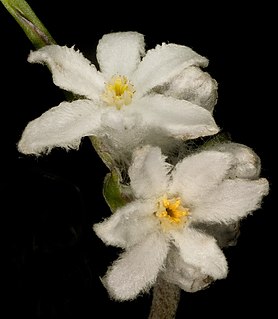
Grevillea is a diverse genus of about 360 species of evergreen flowering plants in the family Proteaceae, native to rainforest and more open habitats in Australia, New Guinea, New Caledonia, Sulawesi and other Indonesian islands east of the Wallace Line. It was named in honour of Charles Francis Greville, an 18th century patron of botany and co-founder of the Royal Horticultural Society. The species range from prostrate shrubs less than 50 cm (20 in) tall to trees 35 m (115 ft) tall. Common names include grevillea, spider flower, silky oak and toothbrush plant. Closely related to the genus Hakea, the genus gives its name to the subfamily Grevilleoideae.

Patersonia is a genus of flowering plants in the family Iridaceae commonly known as native iris or native flag. It was first described as a genus in 1807 by Robert Brown. It is native to Australia, New Guinea, New Caledonia, and insular Southeast Asia. The genus name is a tribute to the first Lieutenant Governor of New South Wales in Australia, William Paterson.

Thomasia is a genus of thirty-one species of flowering plants in the family Malvaceae. Plants in this genus are small shrubs that are endemic to the south-west of Western Australia, apart from P. petalocalyx that is native to Victoria and South Australia. The leaves are simple with leaf-like stipules at the base of the petiole, the flowers bisexual with five papery, petal-like sepals, usually five petals and five stamens opposite the petals. The fruit is a capsule covered with star-like hairs.

Hypocalymma is a genus of evergreen shrubs in the myrtle family Myrtaceae described as a genus in 1840. The entire genus is endemic to southern Western Australia.
Conospermum glumaceum, commonly known as hooded smokebush, is a shrub endemic to Western Australia.

Calytrix is a genus of shrubs in the family Myrtaceae described as a genus in 1806. They are commonly known as starflowers. Calytrix are endemic to Australia, occurring in the.

Comesperma is a genus of shrubs, herbs and lianas in the family Polygalaceae. The genus is endemic to Australia. It was defined by the French botanist Jacques Labillardière in his 1806 work Novae Hollandiae Plantarum Specimen. The genus name is derived from the Ancient Greek words come ("hair") and sperma ("seed"), and relates to the seeds bearing tufts of hair. The genus is distributed over southern Australia, particularly in the southwest of Western Australia, where 19 species are found. 24 species have been described.

Thysanotus is a genus of perennial herbs in the family Asparagaceae, subfamily Lomandroideae. They are mostly native to Australia with 45 of the 50 known species occurring in Western Australia alone, although a few species range northward into New Guinea and Southeast Asia as far north as southern China.

Burchardia is a genus of herbs that are endemic to Australia. The genus is named for Johann Heinrich Burkhardt, a German botanist.

Chamaescilla is a genus of Australian herbs in the subfamily Hemerocallidoideae within the asphodel family. They have grass-like basal leaves and tuberous roots. The flowers have six petals and six stamens. The seed capsules contain black, glossy seeds.

Laxmannia is a genus of tufted perennial herbs in the family Asparagaceae, subfamily Lomandroideae, that are endemic to Australia.

Blancoa is a monotypic genus of perennial herbs in the family Haemodoraceae; the single species is Blancoa canescens, commonly known as the winter bell. It is endemic to the southwestern corner of Western Australia. It has nodding red to pink flowers, a clumping habit and grows to be 10 to 40 cm in height. The genus is named in honour of Francisco Manuel Blanco, a Spanish friar and botanist who compiled the first comprehensive flora of the Philippines.
Elythranthera, commonly known as enamel orchids, was a previously accepted genus of flowering plants in the orchid family, Orchidaceae. It contained two species and a named hybrid, all endemic to the south-west of Western Australia. The genus was first formally described in 1963 by the Australian botanist Alex George who published his description in Western Australian Naturalist. Orchids in the genus Elythranthera had previously been included in Glossodia section Elythranthera.

Johnsonia is a genus five species of herbs in the family Asphodelaceae, all of which are endemic to the south-west of Western Australia. They are grass-like plants with minute flowers surrounded by bracts which are often tinged with white, pink or cream.

Johnsonia pubescens, commonly called the pipe lily, is a grass-like plant in the family Asphodelaceae, subfamily Hemerocallidoideae, endemic to the south-west of Western Australia. As with others in the genus, it is distinguished by its minute flowers which are on the end of a spike and hidden by large, overlapping, papery bracts.

Tribonanthes australis is the type species of the genus Tribonanthes in the bloodwort family, Haemodoraceae in south western Western Australia.

Tribonanthes violacea belongs to the genus Tribonanthes in the bloodwort family, Haemodoraceae. It was first described by Stephan Endlicher in 1846. It is a perennial herb growing from 0.05 to 0.2 m high, in peat, white, grey or yellow sands, clay loams and granite in areas which are seasonally wet and on granite outcrops. Its white to purple flowers are seen from July to October.

Tribonanthes purpurea belongs to the genus Tribonanthes in the bloodwort family, Haemodoraceae. It was first described by Macfarlane and Hopper in 1987. It is a perennial herb growing from 0.03 to 0.04 m high, in seasonally wet moss and herbfields among granite rocks. Its pink to purple flowers are seen in August.

Macarthuria is a genus of dicotyledonous plants belonging to the family Macarthuriaceae, and consists of about 9 species which are endemic to Australia.

Stenopetalum is a genus in the Brassicaceae family which is endemic to Australia. It was first described by Robert Brown in 1821.


















